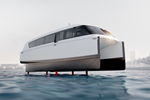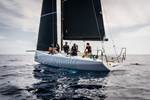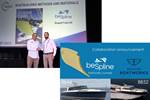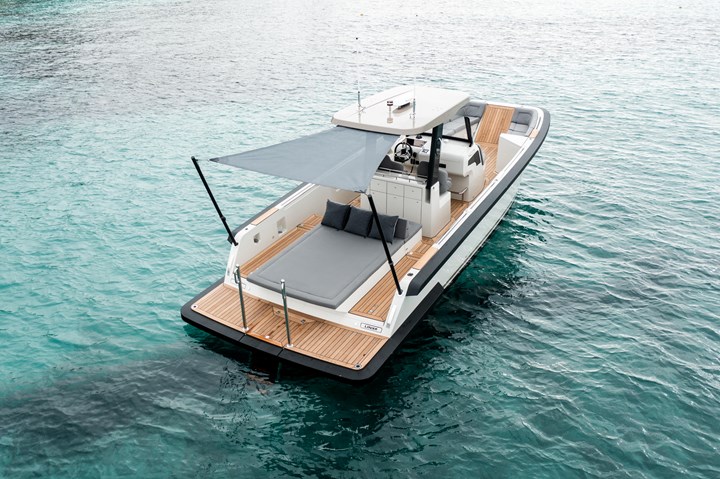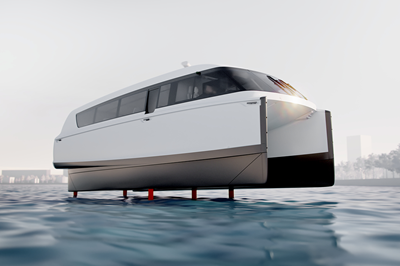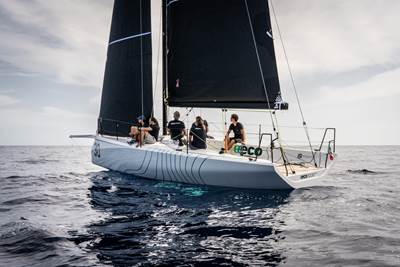BMComposites, Linx Tenders use composites to lighten foiling cats
Glass and carbon fiber meet performance needs for custom-built tenders.
Following the success and strong interest generated by its first Linx 30 foil-assisted catamaran, commissioned as a tender for a 63-meter explorer vessel, Linx Tenders (Palma de Mallorca, Spain) is set to develop a second unit tailored to serve as a luxurious dayboat in the United Arab Emirates (UAE). The 9.5-meter boat is equipped with an advanced foil system to enhance stability, reduce drag and improve efficiency. Similar to its predecessor, the dayboat makes ample use of composites from BMComposites (Palma de Mallorca).
“Although this second unit will look very similar to the first one, we have re-engineered some components and adjusted the production method to better suit its intended use,” says Mark Branagh, CEO of Linx Tenders. The company specializes in crafting tailor-made boats. “The first Linx 30 was constructed entirely from infused carbon fiber to adhere to weight limitations on the mother vessel’s crane, with a primary focus on simplicity for easy maintenance and repairs, even in remote locations. For this second unit, our focus is more on speed and maneuverability. The materials chosen are a mix of carbon fiber and glass fiber, resulting in slightly heavier boats that can accommodate more powerful engines and overall deliver better performance.”
In the construction of the Linx 30 hull, BMComposites used Gurit (Wattwil, Switzerland) Corecell structural foam, specifically designed for marine applications and known for its toughness and impact-resistant characteristics. The composite structure was infused with Prime 37 low-toxicity epoxy resin, which incorporates bio-based content, followed by CNC machining. “This construction method gives superior strength and stiffness,” Branagh says. “It also means we can produce the structure in a one-shot process, eliminating any potential issues with core bonding or voids.” Instead of a gelcoat finish, the boats are painted, ensuring a broader range of color options available to customers.
Onboard equipment for this second catamaran unit is reported to be more sophisticated, with many improvements such as an electric-operated bow door for easier onboard access, a Castoldi Jet to propel the vessel to venture into shallow waters, and features such as joystick control and GPS anchoring.
Moreover, the catamaran’s hydrofoil system provides longitudinal stability and reduces fuel consumption by up to 40%. It includes a main foil situated between the two hulls that lifts the boat, thereby reducing drag, and two smaller aft foils that provide downforce for stability. These foils work together to decrease the impact from waves and reduce pitching.
“The improvement in stability and dryness is so remarkable that during sea trials, we asked people to guess the speed, and every guess was 10 knots less than the actual speed,” Luke Hendy, commercial director of BMComposites, says. “The ride is so smooth and stable that 20 knots on board the Linx 30 feels like 10 knots.”
The second Linx 30 vessel is due to touch the water in December 2023. “We’re working on several inquiries from other clients at the moment, including different length versions such as the Linx 40, a Linx tender that’s solar-powered, an 11-meter Limo and we also have a client who has expressed interest in going fully electric,” Hendy adds. “We’re excited at the prospect of having more Linx tenders on the water.”
Years of composites expertise
Drawing from more than 30 years of experience in the composite industry, BMComposites, the owner of the Linx Tenders brand, has a track record of successfully handled numerous refits and repairs, tackling challenges and providing tailor-made solutions for specific requirements, from major superyacht modifications to upgrades for elite sailing yachts. Standout refit projects for the company include the M5 sailing yacht, the 73-meter Coral Ocean superyacht, the Southern Wind 102 Hevea and the iconic 1930s J-class Velsheda.
At 75 meters, SY M5 (formerly the Mirabella 5) is said to be one of the largest composite sailing yachts ever built and, until recently, sported the tallest mast of any sailing vessel at 89 meters, also constructed with composites. After many years of service, BMComposites was called to carry out an overhaul of the spreader foundations in the mast during an extensive refit of the vessel in 2019. In addition to this, BMComposites, along with designer Adriana Monk, engineered, manufactured and installed three large carbon fiber hardtop biminis to transform the yacht’s flybridge.
BMComposites also played a crucial role in the complete rejuvenation of the 30-year-old Coral Ocean as it embraced its new role as the flagship charter yacht for the Ahoy Club fleet. The previous satellite dome array on the upper deck was removed and replaced with the new “Sky Lounge” — a fully enclosed entertainment area incorporating a cinema, lounge, dining and party spaces. This transformation was part of an extensive refit.
In its persistent quest to improve performance, BMComposites was also turned to for the J-class Velsheda for a planned deck refit to benefit from the tried and tested “core replacement” process to future-proof the longevity of the deck and save weight on the heavy plywood subdeck alternative.
Earlier this year, the Palma de Mallorca-based company showed its talent for quick thinking and innovation by launching a carbon fiber antenna flag pole solution to suit the Starlink Maritime system. This solution addresses signal obstruction issues for sailing superyachts where masts often hinder the signal.
Related Content
Glass fiber-reinforced Akulon RePurposed recyclate enables Ahrend sustainable office chair
Envalior 30% glass fiber-reinforced Akulon RePurposed material helps Ahrend achieve lighter task chair with closed-loop value chain and reduced emissions.
Read MoreCarbon Mobile carbon fiber powers handheld gaming platform
HyRECM technology effectively stabilizes carbon fiber’s electrical and antenna properties, enabling development of next-gen electronics, such as the Snapdragon G3x Gen 2.
Read MoreRepurposing wind blades as functional community art pieces
Ohio-based Canvus Inc. upcycles fiberglass wind blades, car tires and post-consumer plastics to create outdoor furniture that amplifies sustainability messages in community spaces.
Read MoreKraussMaffei and partners develop sustainable, safe and stylish children’s bike
The Lion Bike is a German-made, injection molded bicycle with 40% recycled carbon fibers with zero scrap and enabling 67% lower CO2 emissions during production.
Read MoreRead Next
Sicomin epoxy resins power Candela composite boat construction
Candela’s zero-emission P-12 foiling passenger shuttle offers low vessel weight, higher journey frequency with its carbon fiber-reinforced epoxy fabrication.
Read MoreNlcomp spins off Eco Yachts brand for sustainable composite boat development
Eco Yachts is an Italy-based shipyard that will produce climate-neutral yachts and motorboats with third-party verification using rComposite fiberglass.
Read MoreBeSpline wins IBEX Innovation Award, announces partnership with Boston Boatworks for Shaped Foam Kits
CAD-driven fabrication uses adaptive mold technology for lighter, stronger, higher quality boat structures without time and cost of building a mold while drastically reducing core fitting time for yacht builders.
Read More

